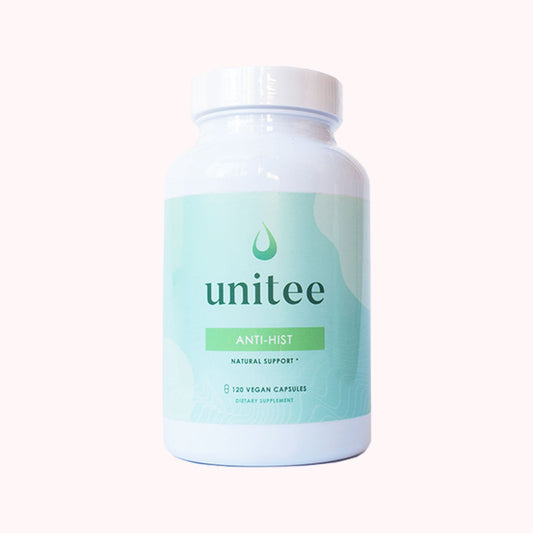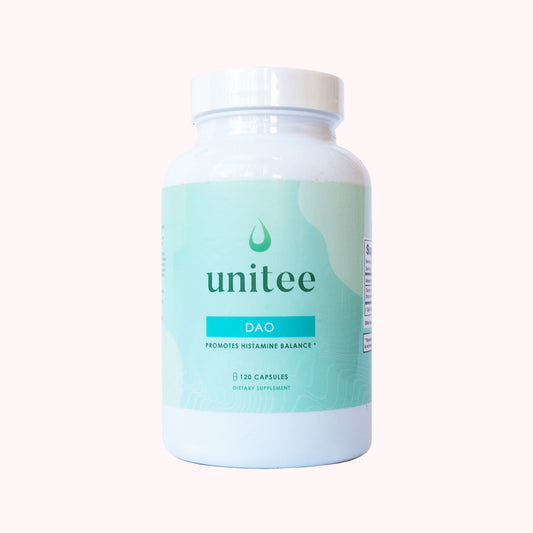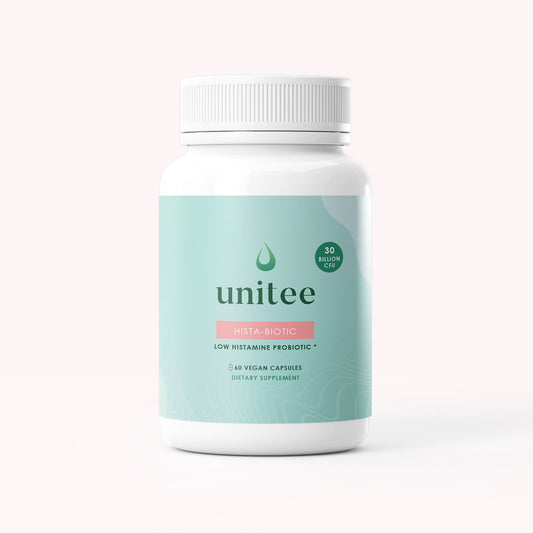Are you someone who takes an antihistamine medication every day to control their runny nose, itchy eyes, tickle in the throat, and skin hives? And are you looking for natural alternatives to antihistamines? If so, this article is for you!
In this post, I’ll give you all of the information you need to know about how to kick your need for meds, and instead, use all natural antihistamine home remedies to control your symptoms.
Let’s dive in.
My Three Go-To All-Natural Antihistamine Home Remedies
Fortunately, we have a wonderful array of evidence-based antihistamine home remedies nature has provided us with that can be a fantastic substitute for those antihistamine meds.
- Vitamin C: there’s no question about it; vitamin C is a potent antioxidant that plays an essential role in all forms of allergic-like diseases. A key nutrient in many fruits and vegetables, vitamin C can also be taken in supplemental form to ensure you’re getting the right dose. Research shows around 2000mg of vitamin C per day can have dramatic antihistamine effects, reducing inflammation and swelling by reducing the response the immune system has to an allergen or trigger (1). Vitamin C may also help to relax the muscles lining the respiratory tract, which may reduce the feeling of shortness of breath associated with allergic-like symptoms. It’s a simple and affordable way to boost your body’s ability to manage histamine reactions, which is why it’s my number one antihistamine home remedy.
- Quercetin: I personally love quercetin for many reasons; it’s yet another potent antioxidant available in many natural foods, but the most important function it has is its ability to moderate and regulate the immune system. In those of you with allergies, it’s likely as a result of a Th1/Th2 imbalance. It means the immune system favours the Th2 pathway (2), which involves processes causing tissues to swell more, cells to secrete more mucus and airways to narrow. Quercetin helps to stabilize the Th2 pathway and balance it out with the Th1 pathway (3), which is well known to protect against allergies. Quercetin is most widely available in supplemental form, where 500mg is typically used twice a day. It may take a few weeks to build the levels up in the body and may not have as much of a quick effect. For this reason, my team and I have put together a quercetin-containing supplement containing additional histamine-stabilizing nutrients, like stinging nettle leaf, which have a quicker response on histamine while you’re building up your quercetin levels.
- Stinging nettle leaf: Speaking of stinging nettle, it is another great antihistamine home remedy to have on hand to control your allergy symptoms. Allergies often develop when the body believes a foreign compound is a threat. Whether it is a credible threat or not, the body’s immune cells, called mast cells, degranulate and release histamine as well as other inflammatory compounds in order to neutralize it. These compounds are what cause the symptoms, but nettle has been shown to keep mast cells from reacting, reducing the risk of symptoms. At the same time, nettle interferes with inflammatory pathways, which further reduces your risk of swelling and inflammation (4). It truly is a natural antihistamine I will always have in my home after going through my own histamine journey. You can opt for stinging nettle in supplemental form, using around 150mg per day, or you can use a stinging nettle tea as a quick, soothing remedy that usually has a quick onset of action (5).
Whether you use one or a combination of all three, there’s evidence to suggest they can be as powerful as those meds you’ve come to rely on to manage your symptoms.
There is one additional nugget of advice I’d like to provide you with to reduce those allergy-like symptoms.
Getting to the Heart of Your Antihistamine Routine
While these are the best natural antihistamine you could add to your routine - and can certainly help to manage your symptoms - there’s one more essential factor to consider. It’s one of my go-to suggestions for my clients who are living with the daily bothersome symptoms mentioned above, such as itching, watery eyes and nose, sneezing and other histamine-related symptoms.
It has to do with your diet. Often, the histamine surge in your body that’s causing your symptoms is not simply related to exposure to pollen or pet dander. It might be due to more histamine being produced by the body, leaving your body more susceptible to allergy-like reactions! So, instead of continuously trying to manage your symptoms with meds, taking a look into your root cause is a way to determine whether histamine intolerance is the actual underlying reason you have these symptoms in the first place.
In order to determine whether this is the case, an easy step to take is to trial a low histamine diet. No matter what the underlying cause of your allergies is, reducing the histamine in your body by reducing histamine-containing food can be quite a significant sign as to what might actually be going on. When your body’s levels of histamine return to more tolerable levels, so does your risk of triggering allergic-like symptoms, and it allows you to take additional steps to address the potential underlying cause of your condition.
If you’d like to give a low histamine diet a trial, read this article, where I explain exactly what to do and what you can expect as a result. You’ll know within a couple of days of following the low histamine diet whether your symptoms are as a result of histamine intolerance, which means you can follow more of my principles to permanently reduce your histamine levels and take full control of the underlying cause of your allergies.
Histamine Intolerance of Allergies - I’ve Got Your Natural Antihistamine Routine Covered
Whether you’re truly histamine intolerant or simply need some additional support to manage your allergies, I hope I’ve given you some options! Give these antihistamine natural remedies a try and watch nature go to work to help you overcome your itchy eyes, runny nose, sneezing, tickle in the throat and hives.
References:
- Ghalibaf MHE, Kianian F, Beigoli S, et al. The effects of vitamin C on respiratory, allergic and immunological diseases: an experimental and clinical-based review. Inflammopharmacology. 2023;31(2):653-672. doi:10.1007/s10787-023-01169-1
- León B. Understanding the development of Th2 cell-driven allergic airway disease in early life. Front Allergy. 2023;3:1080153. Published 2023 Jan 10. doi:10.3389/falgy.2022.1080153
- Jafarinia, M., Sadat Hosseini, M., kasiri, N. et al. Quercetin with the potential effect on allergic diseases. Allergy Asthma Clin Immunol 16, 36 (2020). https://doi.org/10.1186/s13223-020-00434-0
- Bakhshaee M, Mohammad Pour AH, Esmaeili M, et al. Efficacy of Supportive Therapy of Allergic Rhinitis by Stinging Nettle (Urtica dioica) root extract: a Randomized, Double-Blind, Placebo- Controlled, Clinical Trial. Iran J Pharm Res. 2017;16(Suppl):112-118.
- Roschek B Jr, Fink RC, McMichael M, Alberte RS. Nettle extract (Urtica dioica) affects key receptors and enzymes associated with allergic rhinitis. Phytother Res. 2009;23(7):920-926. doi:10.1002/ptr.2763

Anita Tee
My name is Anita Tee. I'm a nutritional scientist who specializes in histamine intolerance. I hold a Master of Science in Personalized Nutrition and a Bachelor of Science in Human Biology and Psychology.
For the past ten years, I have used my experience in nutritional and medical health sciences to create a scientifically backed, natural approach to healthcare that relies 100% on evidence-based research.
As I previously suffered from - and overcame - histamine intolerance, my focus is to increase recognition and expand the available resources and protocols available for resolving this particular disorder. To date, I have helped over 4,000 individuals fully resolve or better manage their histamine intolerance symptoms.







